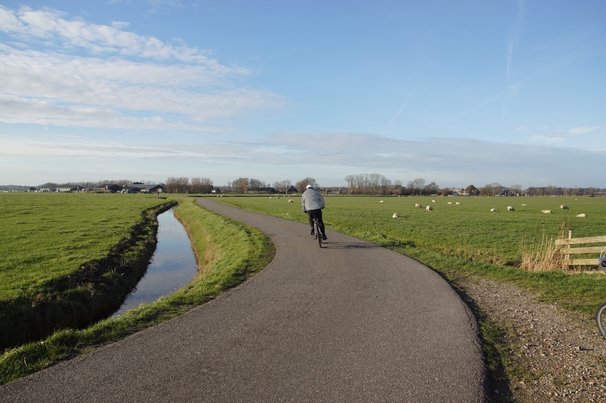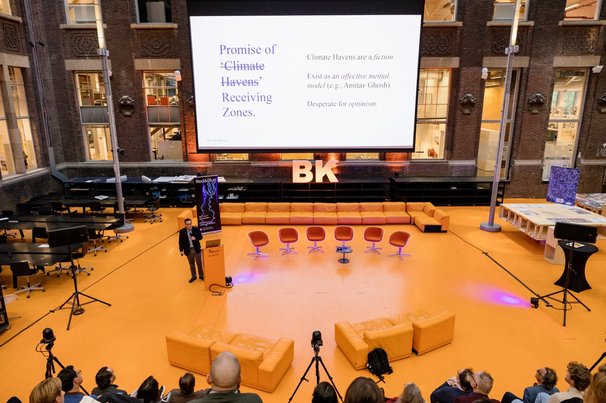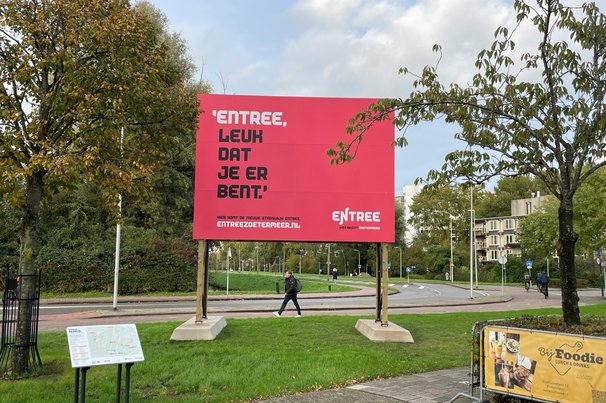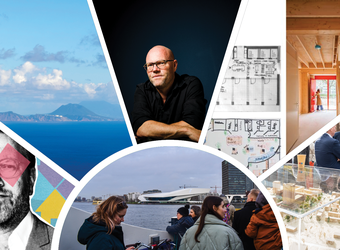Verslag Door het toepassen van een generieke toolbox met ruimtelijke ontwerpingrepen op een specifieke locatie, kunnen specifieke kansen en kwaliteiten van een plek worden gebruikt om tot een gezond ontwerp voor wijk of straat te komen. Dit zegt Han Dijk van stedenbouwkundig ontwerpbureau Posad in zijn lezing ‘Healthy urban environments’. In hun onderzoek naar ruimtelijke principes voor gezonde verstedelijking ligt de nadruk op de directe relaties tussen gezondheid, leefstijl en inrichting van de stad.
Lecture on Designing healthy urban environments
The study on spatial principles for healthy urbanization was commissioned by Rijkswaterstaat, the Ministry of Infrastructure and the Environment, the municipality of Utrecht and the Board of Government Advisors. The origin of this study goes back to the abolition of the Ministry of VROM (Ministry of Housing, Spatial Planning and the Environment); some themes were covered by Rijkswaterstaat and some by the Ministry of Infrastructure and Environment. Health has not been a topic in post-war town planning, urban design and architecture. The Ministry and Rijkswaterstaat asked for a clear vision and a toolbox to make our cities a healthy place to live. The city of Utrecht uses this toolbox as input for their development framework of a large area in Utrecht, the northern site of the train station.
Posad, office for urban design helps governments, NGOs and companies with integrated solutions to complex strategic spatial issues. They work on four topics, which they consider the most important topics for our generation: Urban transformations, Water, Transit oriented development and Energy landscapes.
The close relation of urbanism and health
In times of Industrialization we made rules within our cities in order to ensure certain circumstances during the work in factories. The garden city movement came up with the integration of parks within the city. The Second World War changed the way how health and the city were integrated; the post-war suburbanization lead to neighborhoods where the stress-levels of the inhabitants were almost comparable to the stress-levels people had during the Industrialization. As a reaction, anti-stress neighborhoods were created in the 1970s: the cauliflower neighborhoods where people could relax.
Nowadays we see that people lack movement in their daily routines, people do not know what they eat.
In the perspective of 75% of the world’s population living in cities within 40 years, the Ministry of Infrastructure and Environment asked Posad to develop a generic toolbox to show how we can design our public spaces to make that the city stays a healthy place.

‘A toolbox for healthy urbanization - Afbeelding 1’
Research by design results in a toolbox for healthy urbanization
Dijk explains that they conducted the study by using a methodology divided in three elements: city, human being and lifestyle. Those three elements help to research aspects of a healthy city.
In this respect, it is important to give a clear definition on health in order to know where to strive for.
A healthy city is a city with healthy people. From the building stones of a human being to urban principles
The city offers a context for the human body; with this thought in mind, Posad created an overview of the external factors that relate back to diseases in the human body. This overview led to five commandments of health which can be implemented in people’s lifestyle:
- move more
- breath clean air
- eat and drink healthy
- get enough but not too much sunlight
- reduce stress
Considered from the human body, there are four generic principles formulated with which the urban area may contribute to the human health.
Spatial rules for healthy urban environments
- Healthy movement through the city
- Make public space suitable for: exercise, recreation, meeting and sports
- Synergy between public and private space (work, school, care provision)
- Healthy basic services (drinking water, health care, information, nutrition)

Healthy movement through the city.
‘A toolbox for healthy urbanization - Afbeelding 2’

Make public space suitable for: exercise, recreation, meeting and sports.
‘A toolbox for healthy urbanization - Afbeelding 3’

Synergy between public and private space (work, school, care provision).
‘A toolbox for healthy urbanization - Afbeelding 4’

Healthy basic services (drinking water, health care, information, nutrition).
‘A toolbox for healthy urbanization - Afbeelding 5’
Bringing together policy makers and designers
There are lots of positive feedbacks with other themes that are closely linked to the health of people in the city: climate resilience; water storage, cooling the city, socio-economic problems, power in the city, changing the modal split, and so on. The principles are a plea to bring together policy makers and designers. The combination of knowledge and expertise brings the common goal closer: a healthy city with a fine climate.

‘A toolbox for healthy urbanization - Afbeelding 6’
Healthy city of Utrecht
Dijk explains that they made a development strategy for the city of Utrecht using the formulated principles for healthy urbanization. These principles are used for the city of Utrecht in a test case for the station area at the Jaarbeurs Utrecht CS. The city of Utrecht invests in becoming the healthiest city in Europe and plans to double the size of the center to the other side of the railway. Posad advices to make a sound framework for the city; a structuring network that connects key destinations, downtown and suburbs. Inside are many opportunities on a smaller scale, such as the linking of schools and sports facilities in the surrounding residential areas. Or establishment of the west side of the station along the Merwede channel.
Recommendations to create healthy urban environments, considering the case in Utrecht
- Cooperation between various scale levels and departments
- Better connection between data of the city/use and design
- Make a good link between regulation, spatial interventions and users; a designer thinks differently than a policy advisor
- Broaden design research: healthy home, healthy workplace, healthy school, healthy elderly home, healthy office park
- Create vision for Healthy Framework for the city including the Merwedekanaal
- Test toolbox elsewhere in the city
According to Dijk it would be a good step to integrate health urbanization in ground exploitations and traffic models; to include parameters of health within area development.

Case for the station area at the Jaarbeurs Utrecht CS.
‘A toolbox for healthy urbanization - Afbeelding 7’
Zie ook:
Cover: ‘2015.10.28_A toolbox for healthy urbanization_cover’






